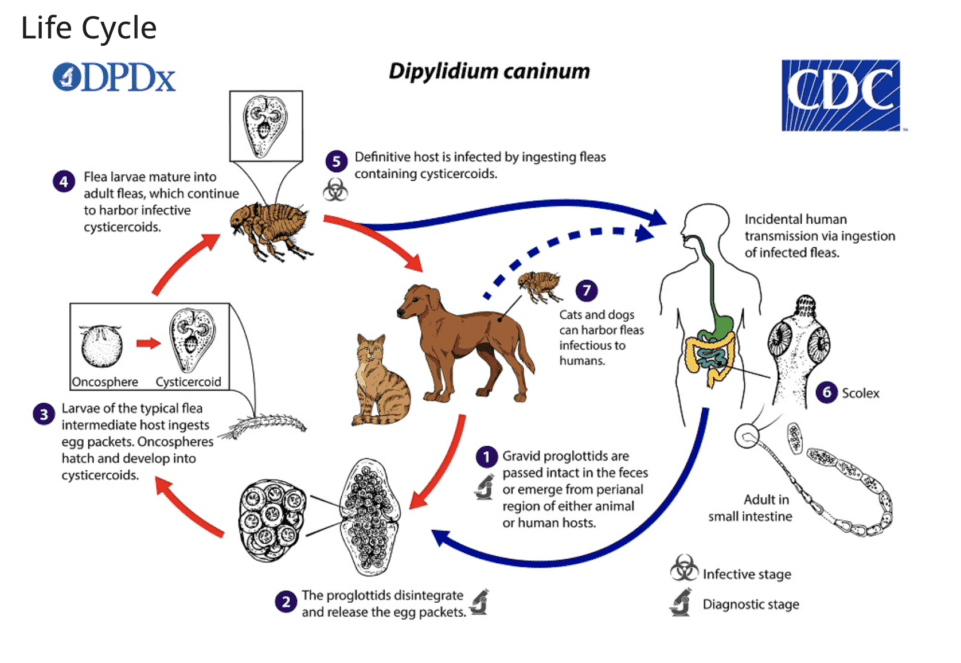Last Updated on October 23, 2022 by Dogs Vets
What are Tapeworms?
Tapeworms are a type of parasite that can affect the intestines. In addition to the roundworm, hookworm, and whipworm, this segmented worm is flat and can be found in humans, cats, dogs, and a wide variety of other animals and species all over the world.
Dipylidium caninum is the species of tapeworm that is found most frequently in dogs.

Cestodiasis is the medical term that is used to refer to an infestation of tapeworms.
If you’ve ever seen pictures of tapeworms, the first thing that probably came to your mind was a sense of automatic revulsion. (Especially those disturbing videos showing tapeworms being extracted from people’s bodies.)
It was reported that a woman in China had an eight-foot tapeworm removed from her stomach!
It is essential to be able to identify the symptoms of parasites, despite the fact that they are revolting to look at. This will allow your dog to be treated before the worms cause any harm to his body.
The treatment for tapeworms is both highly effective and not overly complicated, which is excellent news.
How Do Dogs Get Tapeworms?
There is a vicious cycle that dogs must go through in order to get tapeworms:
How to Tell if Your Dog Has Tapeworms
According to the Centers for Disease Control and Prevention (CDC), the proglottid segments can be seen crawling around near the anus or on the surface of fresh waste at times.
After the proglottid has dried out, these eggs are dispersed into the surrounding environment. Sometimes the dried proglottids will be stuck to your dog’s fur after they have fallen off.
If your dog scoots his anus across the ground, on a rug, or any other rough surface, this is yet another telltale sign that he has worms in his system. This is because the segments are making his skin uncomfortable and irritating it.
There is a possibility that your dog will lick or bite at the affected area. When your dog throws up, there is a remote possibility that some of the tapeworm will be expelled.
In most cases, tapeworms are harmless, and canines almost never become ill as a result of having them.
Tapeworms in dogs and how they live
The tapeworm’s life cycle starts when a dog eats an adult flea that is carrying tapeworm larvae. This is called the intermediate host.
The tapeworm larvae are released into the dog’s small intestine once the adult flea has been eaten. They attach to the wall of the intestine and grow up there.
The proglottid packets that make up the body of an adult tapeworm will break off as the worm continues to grow.
These packets leave the intestine with the poop or move through the anal opening and stick to the fur around a dog’s rear end and tail.
Flea larvae eat the egg packets that fall to the ground and are eaten by them. As the flea larva grows into an adult, they change into immature tapeworm larvae.
Causes of Tapeworms in Dogs
Tapeworms are transmitted to dogs through the consumption of fleas that have been infected with the tapeworm larvae.
It is possible for this to occur while they are grooming themselves if they lick their fur and unknowingly consume an infected flea.
A dog may unknowingly consume a flea that is infected with tapeworms while it is grooming itself or while reacting to a flea bite.
The tapeworm egg is released as the flea is being digested in the dog’s intestines, where it then hatches and attaches itself to the inner lining of the intestinal tract, thereby completing the life cycle of the parasite.
Luckily, there are several safe and effective ways to get rid of worms without using harsh chemicals or leaving your dog feeling uncomfortable.
Tapeworms Diagnosis and Treatment for Dogs
Have you ever questioned the purpose behind your annual physical exam, which requires you to perform the unpleasant task of collecting a fecal sample and bringing it with you to the clinic?
The correct response is that this is how he checks for worms.
The test will determine whether or not your dog has tapeworms by examining either the anal sac or the feces. The tapeworm test is reliable, and the majority of the results are definitive; however, there is a possibility of false negatives occurring.
Following treatment, there is a very high likelihood of a favorable outcome for both animals and humans.
Oral or injectable administration of the prescription medication praziquantel is acceptable treatment options for tapeworms. Because of the medication, the tapeworm completely dissolves within the intestinal tract.
In most cases, the medication does not cause any unfavorable side effects. Other medications that are effective in removing tapeworms include chewables, granuals, and other forms of the medication.
Can Tapeworms Be Passed Along to Humans?
It is possible for humans to become infected with tapeworms, but the likelihood of this happening is extremely remote.
In order to become infected, a person would have to ingest an infected flea, or in the case of certain species of parasites, accidentally consume feces that contain parasitic eggs.
Children are particularly at risk for this condition because they are more likely to spend time playing outside in areas such as grass, parks, and other places where dog waste may be left behind.
Prevention of Tapeworms in Dogs
Dogs are the best of friends, right? But sometimes they can be pesky pests. Worms in particular can be a major problem, and can even lead to tapeworms.
Prevention is the key to keeping your dog worm-free, so make sure to take preventative measures.
The best way to protect your dog from getting tapeworms is to make sure that he does not have a flea infestation.
In order to stop further infestations from happening, the surrounding environment needs to be treated as well.
One of the best ways to do this is by feeding your dog premium quality kibble that is natural and free from fillers and preservatives.
Another key step is to make sure you clean up any feces left behind – this will help reduce the chances of tapeworms developing in your dog. If all else fails, call a professional!
Home Remedies for Tapeworms
Dogs are man’s best friend, and for that reason, they’re often treated to worms. Unfortunately, worms can be a real pain for both dog and owner.
If you’re experiencing any of the following symptoms, it’s likely that your dog has worms: loss of appetite, vomiting, diarrhea, and excessive thirst.
In order to get rid of worms safely and quickly, try some of these home remedies: apple cider vinegar or enzyme cleaner capsules.
Remember to consult a veterinarian if your dog is exhibiting serious signs like bloody stools or seizures. So don’t wait – get rid of those worms today!
Please keep in mind that the purpose of this article is to help educate you about tapeworms in dogs; it is not intended to serve as a substitute for a diagnosis or consultation provided by a veterinarian.
If you suspect that your dog has tapeworms or any other kind of parasite, you should contact your veterinarian as soon as possible to schedule an appointment for an examination. This will ensure that your dog receives the treatment that is both safe and effective.
Facts Check
We hope you enjoyed this article… What are your thoughts?
Please feel free to share this article!

















